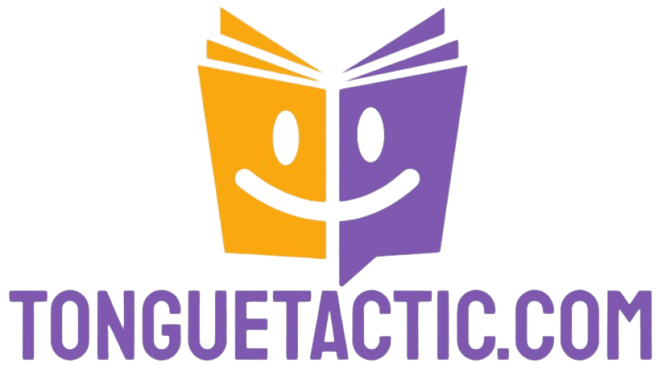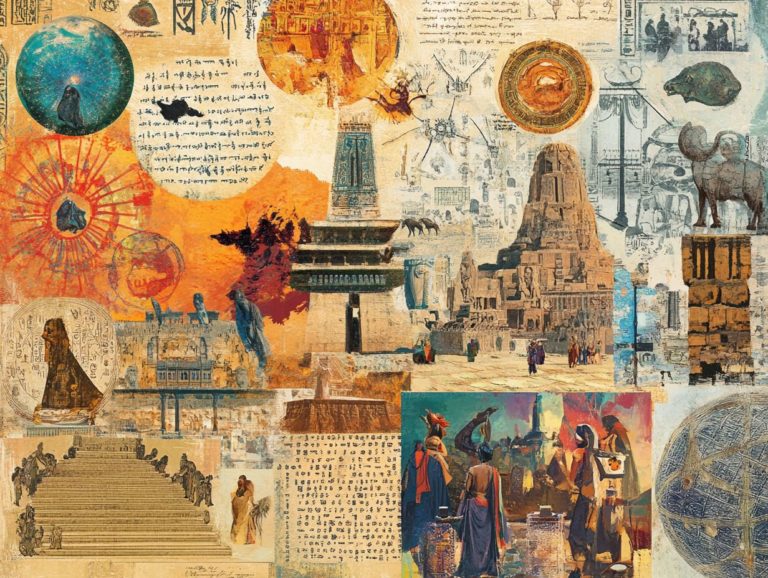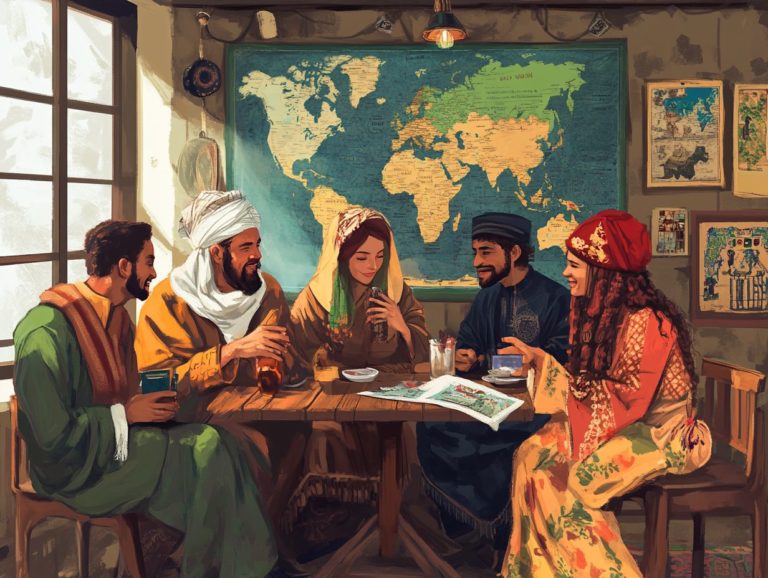exploring language through cultural storytelling
Storytelling transcends mere entertainment; it wields a profound influence that shapes your understanding of language and identity.
Let s explore how stories serve as mirrors, reflecting cultural nuances and safeguarding traditions, particularly within Indigenous cultures. You will delve into the intricate relationship between language evolution and cultural narratives. This journey uncovers how storytelling enhances both vocabulary and grammar.
Discover powerful strategies for harnessing storytelling as a dynamic tool in your language acquisition journey. Join us to navigate the rich tapestry of connections between storytelling and culture.
Contents
- Key Takeaways:
- The Role of Storytelling in Culture
- The Connection Between Language and Culture
- The Power of Narrative in Preserving Culture
- Language and Storytelling in Indigenous Cultures
- The Influence of Cultural Storytelling on Language Evolution
- Using Storytelling to Learn a Language
- Frequently Asked Questions
- 1. What is the significance of exploring language through cultural storytelling?
- 2. How does cultural storytelling contribute to language learning?
- 3. What are some examples of cultural storytelling?
- 4. How does exploring language through cultural storytelling promote cultural appreciation?
- 5. Can cultural storytelling be used to teach language to children?
- 6. How can I incorporate cultural storytelling into my language learning journey?
Key Takeaways:

2. The connection between language and culture goes beyond words; exploring cultural nuances is key to understanding a language.
3. Narrative and storytelling are powerful tools in preserving a culture’s traditions and values.
The Role of Storytelling in Culture
Storytelling holds an important place in shaping culture. It serves as an important way to pass down traditions and values through the ages.
Consider the rich oral traditions of Native American tribes, like the Choctaw, whose storytelling practices weave intricate narratives that connect their history to the present. Think of the griots, who are traditional storytellers in Western Africa, who meticulously preserve historical tales, embodying the essence of cultural identity.
Similarly, the Jewish Passover and the Irish seancha illustrate the profound importance of storytelling in nurturing cultural cohesion. They foster a sense of community and continuity, binding people together through shared ancestral stories that resonate across generations.
How Stories Shape Language and Identity
Stories are essential for shaping your language and identity. They provide a narrative context that you and your community can resonate with.
Through storytelling, you forge emotional connections, cultivating a sense of belonging and cultural identity that inevitably influences how you use and perceive language. This intricate relationship is vividly illustrated in various cultural traditions where elders share tales that embody their community’s values and experiences, showcasing how to explore cultural heritage through language learning.
For example, Indigenous storytelling not only preserves history but also enriches the language unique to those traditions, capturing the essence of shared experiences and beliefs.
Immigrant communities weave their narratives into a new language seamlessly, transforming it into a powerful tool for cultural expression. Such practices enable you to assert your identity and foster connections, creating a vibrant tapestry where stories and language intertwine, serving as a vital link to your heritage.
The Connection Between Language and Culture
Language and culture are intricately intertwined, with the power of language learning through storytelling acting as a vital bridge that connects the two.
Cultural values are woven into the fabric of language, shaping the ways individuals communicate, express emotions, and share historical narratives. This relationship is crucial for effective language learning; immersing yourself in a culture not only enriches your understanding but also significantly enhances your ability to acquire its language.
Exploring Cultural Nuances in Language
Exploring the cultural nuances embedded in language is essential for effective communication. It equips you to grasp the subtleties that shape your interactions and relationships.
Storytelling practices serve as a unique lens through which you can examine these nuances, offering valuable insights into community values and fostering empathy.
Take, for instance, Indigenous cultures, where oral narratives often convey profound lessons about the land and interpersonal connections, highlighting a deep bond with nature and the community.
Similarly, Japanese folklore, with its intricate blend of myth and moral teachings, showcases the importance of harmony and collective well-being.
These rich storytelling traditions enhance your awareness of cultural expectations, enabling you to understand the emotional undertones that guide conversations. By grasping these elements, you not only strengthen your relationships but also enrich your ability to engage meaningfully in our increasingly interconnected world.
The Power of Narrative in Preserving Culture
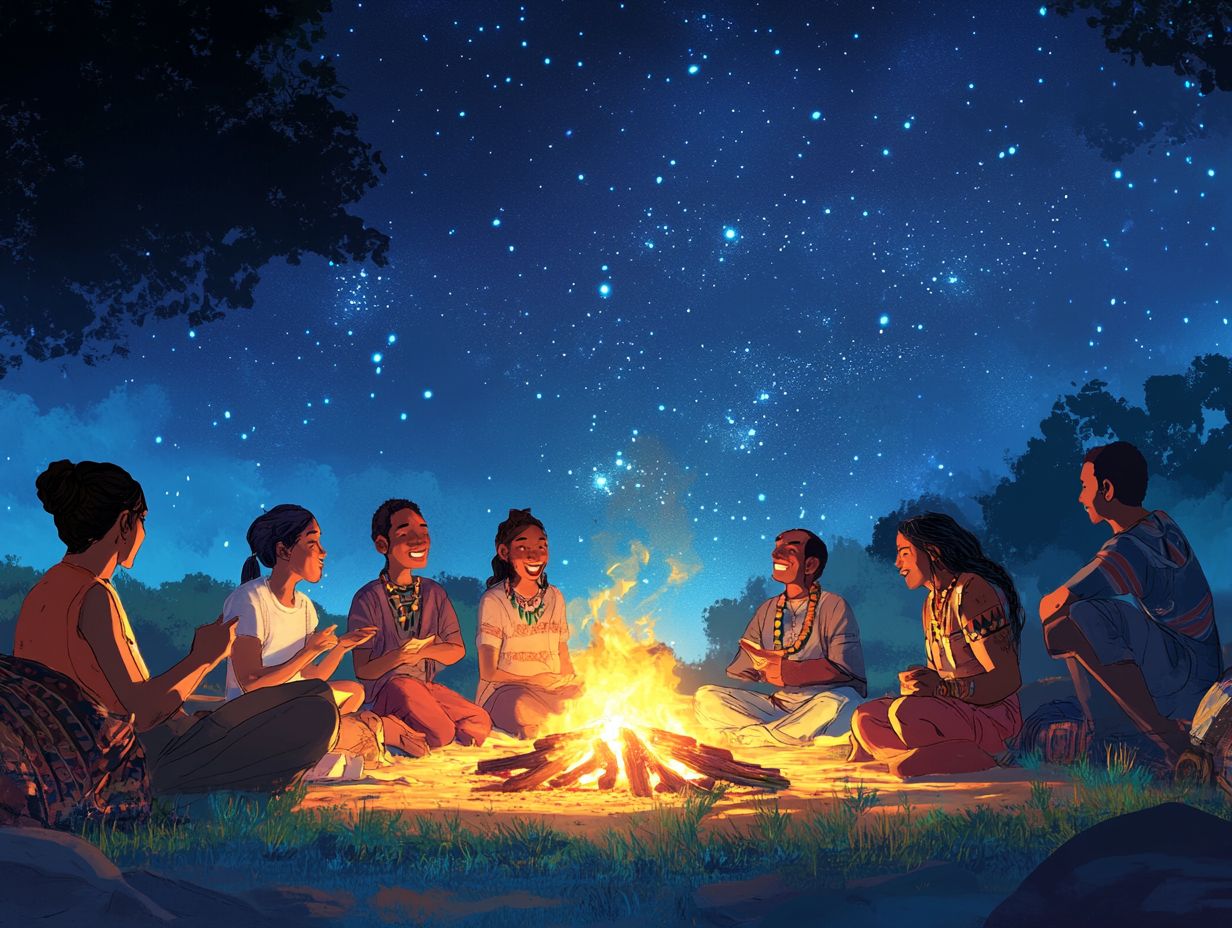
Narrative is a powerful tool for preserving culture. It helps you and your community resist cultural erasure and maintain your unique identities.
Through storytelling, these narratives are shared and passed down. They reinforce cultural values and cultivate a profound sense of belonging.
This practice is especially vital in the context of decolonization. The preservation of identity is crucial during these times.
How Stories Pass Down Traditions and Values
Stories play a crucial role in passing down traditions and values. They serve as a storehouse of wisdom from our ancestors that nurtures cultural cohesion.
These stories encapsulate the beliefs, customs, and practices of communities. They ensure that you and future generations appreciate your cultural heritage.
From ancient folklore to contemporary tales, storytelling weaves a rich tapestry of shared identity. For example, Indigenous tales of North America often center around the natural world.
These stories convey vital lessons about respect and balance with nature. They embody principles of sustainability and harmony.
Aesop’s Fables are filled with moral insights. They do more than entertain; they instill virtues like honesty and kindness, transcending time and cultural boundaries.
These examples illustrate how stories integrate lessons into daily life. They foster societal bonds and enrich our collective memory.
Language and Storytelling in Indigenous Cultures
Language and storytelling are at the heart of indigenous cultures. Oral traditions serve as vital threads in preserving cultural identity and heritage.
Through rich narratives, indigenous communities share their history, spiritual beliefs, and social values. This ensures that essential elements of their culture not only survive but thrive.
Oral Traditions and Language Preservation
Oral traditions play a crucial role in preserving languages. They enable communities to uphold their linguistic heritage and cultural values across generations.
Storytelling is a powerful tool in this effort. It engages listeners while imparting wisdom and knowledge embedded in the culture.
Through vibrant tales, you witness how communities pass down intricate narratives. These narratives connect individuals to their roots and reinforce a collective identity.
For instance, Indigenous tribes that share Creation Stories reflect their beliefs and values. They also preserve the unique dialects and expressions distinctive to their languages.
Similarly, the West African tradition of Griot storytelling intertwines history and moral lessons. Rhythmic performances captivate audiences and foster appreciation for a rich linguistic tapestry.
As these stories unfold, they do more than entertain. They instill pride and promote cultural continuity, highlighting the critical role of oral traditions in safeguarding language and heritage.
The Influence of Cultural Storytelling on Language Evolution
Cultural storytelling profoundly impacts the evolution of language. It shapes both vocabulary and grammar as it mirrors societal changes and interactions.
As cultures intertwine and hybrid languages emerge, storytelling becomes a vital conduit for these transformations. It showcases the ever-evolving nature of language.
What stories from your culture do you cherish? Share them with your community!
Impact on Vocabulary and Grammar

The impact of storytelling on your vocabulary and grammar is truly profound. Narratives introduce you to new words and phrases while subtly shaping the structures of your language.
As you share stories, your community adapts its language, infusing it with cultural references that reflect unique experiences. These narratives do much more than entertain; they act as powerful vehicles for language evolution, influencing how you express ideas and emotions.
Take, for instance, the way idiomatic expressions often spring from popular tales, seamlessly weaving into your daily conversations and transforming grammatical usage in the process.
When stories from one culture are translated or retold in another, they tend to carry specific terminology that lacks direct equivalents, prompting the incorporation of new words into your speech.
The rhythm and structure of storytelling marked by varied sentence lengths and playful punctuation can inspire you to embrace more complex grammatical constructions, ultimately enriching the language you use every day.
Using Storytelling to Learn a Language
Using storytelling as a tool for language learning presents a unique and interesting way that nurtures cognitive development and fosters empathy.
By immersing yourself in narratives, you can acquire language skills in a context-rich environment, significantly enhancing your understanding and retention of the material.
Benefits and Strategies for Language Acquisition
The benefits of storytelling in language acquisition are remarkable, enhancing comprehension and emotional engagement.
To leverage storytelling effectively, consider employing strategies like interactive learning, contextual exploration, and integrating historical narratives that resonate with your learners. These methodologies allow you to craft immersive experiences that nurture linguistic skills.
For example, implementing story circles, where students take turns narrating different parts of a story, offers them a chance to practice both speech and listening skills in a supportive atmosphere.
By incorporating visual aids like illustrations or props you can elevate the storytelling experience, making it truly memorable.
Choosing culturally relevant stories promotes diversity and ensures that your students can connect with the content, which boosts their motivation and interest in language learning.
Frequently Asked Questions
1. What is the significance of exploring language through cultural storytelling?
Exploring language through the power of storytelling in language and culture allows us to gain a deeper understanding of different cultures and their unique perspectives. It helps us celebrate the rich diversity of languages and cultural traditions.
2. How does cultural storytelling contribute to language learning?
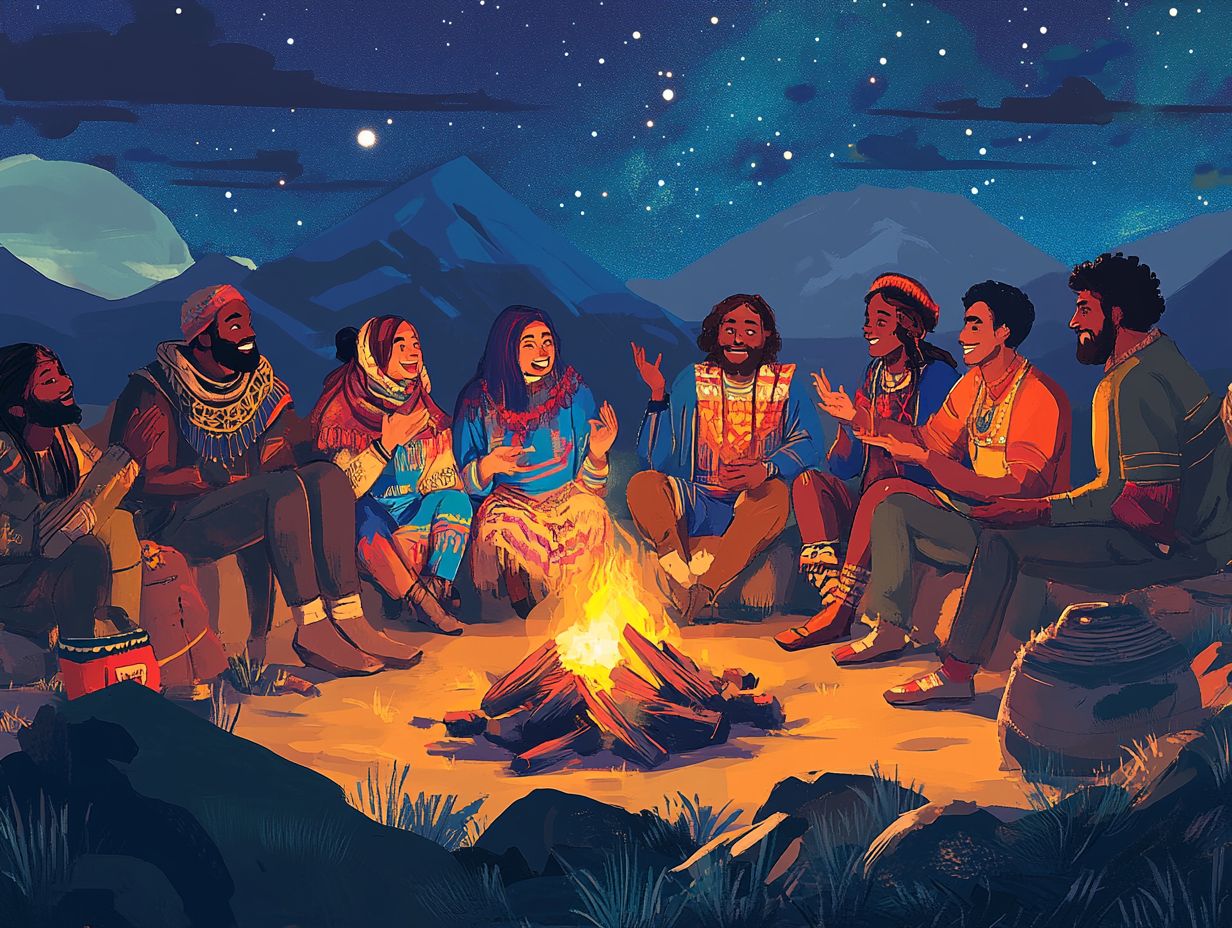
Cultural storytelling provides a more engaging and immersive way to learn a language. By hearing stories and legends from different cultures, language learners can improve their vocabulary, grammar, and cultural awareness.
3. What are some examples of cultural storytelling?
Cultural storytelling can take many forms, such as folktales, myths, legends, and fables. Oral traditions, literature, and performing arts are also important mediums for sharing stories and preserving cultural heritage.
4. How does exploring language through cultural storytelling promote cultural appreciation?
By learning about different cultures through their stories, we are able to gain a deeper understanding and appreciation for their beliefs, values, and traditions. It helps break down cultural barriers and promotes diversity and inclusivity.
5. Can cultural storytelling be used to teach language to children?
Yes, cultural storytelling is an effective way to teach language to children. It makes language learning more fun and interactive, and also helps instill cultural awareness and understanding from a young age.
Start incorporating storytelling into your language learning today!
6. How can I incorporate cultural storytelling into my language learning journey?
Incorporate cultural storytelling into your language learning by exploring stories and legends from the culture of the language you’re learning.
Participate in cultural events and join language exchange groups to hear and share exciting stories with native speakers!
